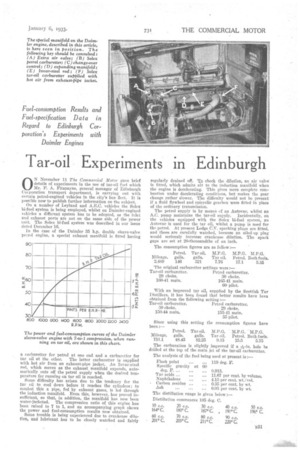Tar-oil Experiments in Edinburgh
Page 45

If you've noticed an error in this article please click here to report it so we can fix it.
0 N November 11 The Commercial Motor gave brief details of experiments in the use of tar-oil feel which Mr. F. A. Fitzpayne, general manager of Edinburgh Corporation transport department, is carrying out with certain petrol-engined vehicles in the city's bus fleet. It is possible now to publish further information on the subject.
On a number of Leyland and A.E.C. vehicles the Solex hi-fuel system is being employed, whilst on Daimler-engined vehicles a different system has to be adopted, as the inlet and exhaust ports are not on the same side of the power unit. The Solex bi-fuel system was described in our issue dated December 16.
In the case of the Daimler 35 h.p. double sleeve-valve petrol engine, a special exhaust manifold is fitted having a carburetter for petrol at one end and a carburetter for tar oil at the other. The latter carburetter is supplied with hot air from an exhaust-pipe jacket. An Invar-steel rod, which moves as the exhaust manifold expands, automatically cuts off the petrol supply when the desired temperature for running on tar oil is reached.
Some difficulty has arisen due to the tendency for the tar oil to cool down before it reaches the cylinders ; to combat this a pipe, fed by exhaust gases, is led through the induction manifold. Even this, however, has proved insufficient, so that, in addition, the manifold has now been water-jacketed. The compression ratio of this engine has been raised to 7 to 1, and an accompanying graph shows the power and fuel-consumption results now obtained.
Some trouble is being experienced due to crankcase dilution, and lubricant has to be closely watched and fairly regularly drained off. rile check the dilution, an air valve is fitted, which admits air to the induction manifold when the engine is decelerating. This gives more complete combustion under decelerating conditions, but makes the gear change rather slower. The difficulty would not be present if a fluid flywheel and epleyclic gearbox were fitted in place of the ordinary transmission.
The petrol supply is by means of an Autovae, whilst an A.C. pump maintains the tar-oil supply. Incidentally, on the vehicles equipped with the Solex bi-fuel system, an Autovac is used for the tar oil, whilst a pump is used for the petrol. At present Lodge C.V. sparking plugs are fitted, and these are carefully watched, because an oiled-up plug would seriously increase crankcase dilution. The spark gaps are set at 20-thousandths of an inch.
The consumption figures are as follow :— Petrol. Tar oil. M.P.G. M.P.G. M.P.G.
Mileage. galls. galls. Tar oil. Petrol. Both fuels.
2,489 146 321 7.70 17.1 5.35 The original carburetter settings were Tar-oil carburetter. Petrol carburetter.
29 choke. 30 choke.
160-41 main. 165-41 main.
60 pilot.
With an improved tar oil, supplied by the Scottish Tar Distillers, it has been found that better results have been obtained from the following setting :— Tar-oil carburetter. Petrol carburetter.
30 choke. 29 choke.
150-44 main. 155-41 main.
55 pilot.
Since using this setting the consumption figures have been :— Petrol. Tar oil. M.P.G. M.P.G. M.P.G.
Mileage, galls. galls. Tar oil. Petrol. Both fuels.
751.1 48.45 82.25 9.15 15.5 5.75 The carburation is slightly improved if a -s-in. hole be drilled at the top of the main jet of the tar-oil carburetter.
The analysis of the fuel being used at present is :—




























































































